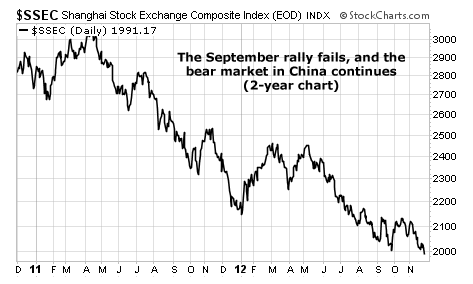| Home | About Us | Resources | Archive | Free Reports | Market Window |
When It's OVER... and When It's Finally Time to BuyBy
Thursday, November 29, 2012
"Porter, how do we know when THIS will finally be over... And how do we know when it will finally be time to buy?"
Porter Stansberry was put on the spot...
He was on stage in front of hundreds of our Stansberry Research lifetime subscribers at our Alliance meeting last month.
Instead of giving the man a fish, Porter taught the man to fish...
"One of the first things I learned from Steve Sjuggerud in the mid-1990s was this: It ain't over until it's completely out of the news."
Porter gave a perfect example to the crowd. He explained the Asian Crisis that started in 1997...
Thailand's currency crashed in the summer of 1997, kicking off the Asian Crisis. It sucked in country after country, and it was all over the news. Everyone was looking for the bottom – the time to buy. Brilliant hedge-fund managers like Victor Niederhoffer went bust trying to time the bottom.
Stock prices kept going lower, and people kept trying to time the bottom. Indonesian stocks lost 90% of their value (in U.S. dollar terms) from June 1997 to June 1998.
It then took a couple years for the Asian Crisis to fall out of the news – for people to forget about it and give up completely. Then – when nobody was paying attention – Indonesian stocks soared 10-fold from late 2002 to late 2007.
Indonesia wasn't a 10-fold-better place by 2007 – investors had just given up so much on the place that the upside potential was dramatic.
What about today? What place is completely out of the news, but has dramatic upside potential?
Japan...
Japan was all the rage a few decades ago. "It would not be surprising if the 21st Century turned out to be the Japanese Century," futurist Herman Kahn said back then. (Kahn was the inspiration for the movie character Dr. Strangelove.)
Boy, did Kahn get that one wrong! Japanese stocks peaked on the last day of 1989 near 40,000 on the Nikkei Index. Today – nearly a quarter-century later – the Nikkei stock index is less than 10,000.
Japan has performed terribly. But now – importantly – nobody is paying attention. Meanwhile, as I write, the Nikkei index has soared 800 points in the last two weeks. I told you why earlier this month.
Since Japan is completely out of the news, I assume you didn't take me up on my suggestion. So I am repeating it.
Japanese stocks are cheap, ignored, and now in an uptrend. With these three things in place, we have everything we look for in an investment.
Japanese stocks are now offering us the True Wealth "trifecta."
Porter gave my favorite advice for when a bottom is finally here. My friend, I think the bottom might finally be here in Japanese stocks.
Trade accordingly.
Good investing,
Steve
Further Reading:
Japan's government is creating a powerful "tailwind" for the country's stocks. As Steve writes, "It appears Japan will be the next country drinking Fed Chairman Ben Bernanke's Kool-Aid. Buying Japanese stocks is the best way to take advantage of the situation..." Read his full argument here: Japanese Stocks Are Up 400 Points in Three Days... More to Come?
DailyWealth classic: Porter was the inspiration for one of Steve's most popular essays. If you want to be more successful at what you do in a shorter period of time than anyone you know, this is a must-read: Seven Secrets from the Smartest Businessman I Know.
Market NotesTHE BEAR MARKET IN CHINA CONTINUES The market keeps siding with the bears in the big China debate...
Regular readers know China is the center of a great financial debate. Some world-class analysts and investors, including Jim Chanos, say the country is a powder keg of government malinvestment... which will cause a big economic slowdown. On the other hand, you have many "China bulls," who say the bearish arguments are overblown and overhyped.
China is a major cog in the world economy, so this debate is worth monitoring. One way to monitor it is with the Shanghai Stock Exchange Index (SSEC). You can think of it as the "Dow Industrials of China." It tracks the largest and most important Chinese companies.
The Shanghai Index has been in a bear market for several years. Back in September, it reached a low of 2,004. This looked like a potential bottom for Chinese stocks. The index rallied past the 2,100 level. But in just the past few weeks, it dropped below 2,000... and struck its lowest level since January 2009. The bear market in China continues... but our interest in buying "left for dead" assets is now piqued.
– Brian Hunt
 |
In The Daily Crux
Recent Articles
|


